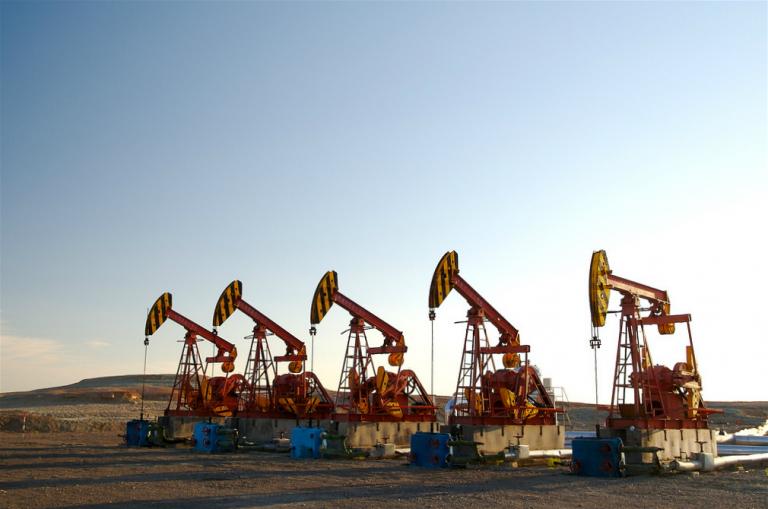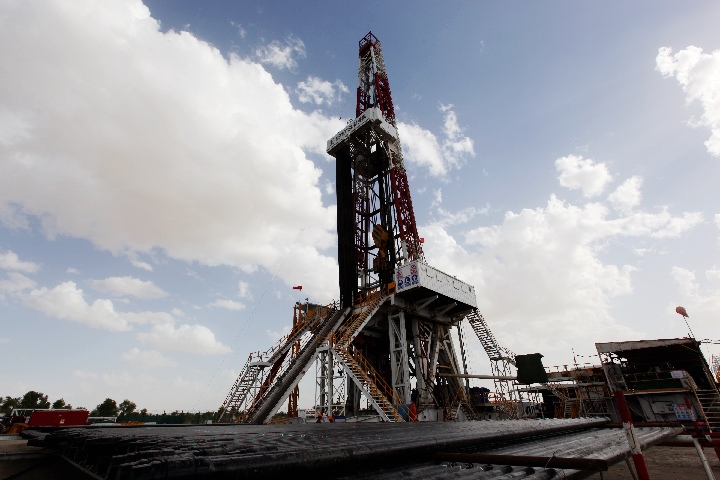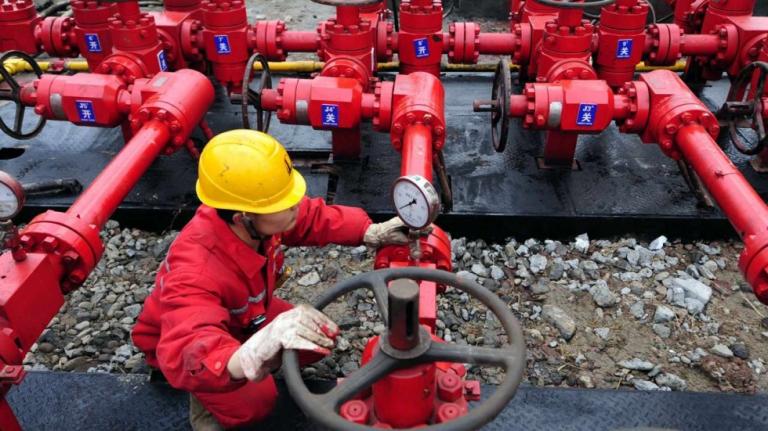Oil and gas in Xinjiang
7 min read“The magnificent country is picturesque, national construction is developing rapidly, oil workers are so proud and walk across the land wearing aluminum helmet”the song of Produce Oil for My Motherland expresses vividly the masculinity of oil workers, and has stimulates generations of oil workers to devote themselves to the petroleum industry of China, and these workers are writing splendid chapters of oil industry development with lofty sentiments and aspirations.”Oil derricks stand in the vast grasslands, and we drill oil wells in the misty depth”,”confronting the fluffy snow coming from Tianshan Mountains and the wind and sand of Gobi deserts… until the sunset clouds fade under Kunlun Mountains”, all these descriptions make people think of the oil drilling machines at the foot of Tianshan Mountains and Gobideserts. Now, more and more oil drilling machines stand inall areas in Xin jiang and become beautiful scenery at the foot of Tianshan Mountains…

Xinjiang has a very time-honored history of oil discovery and utilization. As early as more than 1,400 years ago, Xin jiang has had the record about oil being used on medicine. In 1897, Xinjiang Business Administration in Qing Dynasty set plant and excavated oil in Dushanzi Area. In 1909, Xin jiang Business Administration purchased oil digging machines from Russia, hired Russian craftsmen and dug oil well in Dushanzi Area and found oil and gas, which is the first oil well dug with modern machine in Xin jiang and shall be the beginning of modern oil industry in Xin jiang. Before the founding of the People’s Republic of China, the oil and gas industries in Xinjiang were very weak and the accumulated crude oil production volume from 1942 to 1950 is less than that produced in one day at present.Since the discovery of the first large continental oilfield in China-Karamay Oilfield inXin jiang in 1955, oil and gas exploration and development have intensified in Xin jiang, Tarim Oilfield, Turpan-Kumul Oilfield, Tarim Oilfield, and other large oil fields are constructed successively, showing the good momentum of the common development of oil and gas and reserves and production volume growing together, which makes Xin jiang have become an important base of oil and gas industry in China.
In May 1978,”Xinjiang Oil Prospecting and Exploration Headquarters”was organized on the basis of the former First Prospecting and Exploration Team of National Geological Exploration of China and moved in Xinjiang from Qinghai, renamed as Northwest Petroleum Geology Bureau of Ministry of Geology in 1983. On September 22,1984, the breakthrough of Shacan No.2 well marks the beginning of Tarim oil and gas development and is an important milestone in the history of Tarim Basin development in Southern Xinjiang. In 1989 and 1991, the Tarim Petroleum Exploration and Development Headquarters and Turpan-Kumul Petroleum Exploration and Development Headquarters were established respectively and mobilized exploration, construction teams of the national petroleum system entered and were stationed in Tarim Basin and Turpan-Kumul Basin, and launched petroleum exploration and development. In January 1997, China New Star Petroleum Corporation (later renamed as China New Star Petroleum Northwest Petroleum Bureau) was established and found the ultra-large Tahe oilfield of a hundred million tons. In 2000, China New Star Petroleum merged into the China Petrochemical Group, and established Northwest Oilfield Branch of Sinopec Corporation. With the successive development of Edin Blocks of Tahe Oilfield, the exploration and development of Tahe oilfield have been further expanded.
Xin jiang covers an area of 1.66 millionkm², and accounts for 1/6 of China’s land area; there are 34 sedimentary basins with an area of 973,000km², accounting for 1/5 of the sedimentary rock area in China. Tarim Basin, Junggar Basin and Turpan-Kumul Basin cover a total area of 738,000km² which are rich in plentiful oil and gas resources and have become important oil and gas production bases in China. According to the third resource evaluation report, the prospective resource amount in Xin jiang is 21.3 billion tons, accounting for 20% of the amount of oil resources of China’s ma jor oil-and-gas-bearing basin; the prospective gas resources is 10.8 trillion m², accounting for 32% of the natural gas resources of China’s ma jor oil and gas basins. Crude oil production in Xin jiang increased to 25,582 million tons in 2010 from 24083 million tons in 2005, and Xinjiang has become the third largest oil producing area in China; natural gas production increased to 24.99 billion m³ in 2010 from 10.63 billion m³ from 2005 (including the 19.8 billion m³ of West-East Gas Transmission), and have ranked first in China from 2006 onwards.
According to the statistics of regional geological survey and satellite remote sensingimage, Xinjiang has 49 Cenozoic basins among which there are 25 basins with oil and gas prospects, and the sedimentary rock area available for exploration is about 900,000m².Besides that, the three large basins of Tarim Basin, Junggar Basin and Turpan-Kumul Basin have been identified to be rich in oil and gas resources, oil and gas fields are also discovered in Santang Lake and Yanqi Basin and some oil and gas resources survey has also been conducted in other basins.
Xinjiang is rich in oil and natural gas resources and the total proved reserves of oil and natural gas resources are in the forefront of China. However, the proven degree of oil and natural gas is low and the proven degree of 12.91% is lower than the 20.91% of China.Specifically, in terms of the three basins, after oil and gas exploration for half a century, most oil deposits which are buried in shallow area with simple types, good ground conditions and low technical requirement are found, vast ma jority of oil and gas resources for further exploration are buried deeply with complex types, poor ground conditions and high technical requirements of high, resource transformation will be more and more difficult; seen from resource abundance, the controlled and predicted areas do not have high abundance is not high, which will cause the costs for future exploration increase, but will bring better resource efficiency. The ma jority of crude oil resources in Tarim Basin are deeply buried, the ground conditions are poor, abundance is not high, and the exploration costs are high with the average depth at 4,000 m. But the Tarim Basin is the gas enrichment region in Central Asia and has great similarities in petroleum geology and similar oil forming conditions; therefore, it has the potential for forming a world-class natural area.Turpan-Kumul Oilfield is still in the primary stage of oil and gas discovery and development and reserves increase. In terms of geological conditions, it has the geological conditions for forming large and medium-sized oil and gas fields; in terms of resources amount, it has the material basis for transforming into reserves; in terms of exploration practice, there is the potential for finding bulk oil and gas field and maintaining oil and gas reserves.
Xinjiang now has formed large oil fields whose annual output exceeding 1 million tons, namely, Karamay Oilfield, Huoshaoshan Oilfield, Cainan Oilfield, Turpan-Kumul Oilfield, Shixi Oilfield, Tahe Oilfield, Tarim Oilfield and four petroleum exploration and development companies of Xin jiang Oilfield Company, Tarim Oilfield Company, Turpan-Kumul Oilfield Company and the Northwest Branch of Sinopec Group.
In the exploration and development of oil and gas resources vigorously, meanwhile, Xinjiang has also accelerated the development of oil processing and chemical industries.Xinjiang has built three ma jor oil and gas production bases in Junggar Basin, Tarim and TurpanKumul Basin, and four ma jor oil refining bases in Dushanzi-Karamay, Urumqi, Turpan-Kumul and Southern Xinjiang; petrochemical industries of big ethylene, ethylene, big arene, fertilizers with petroleum and natural gas as ma jor raw materials are rapidly emerging, and can be able to produce various types of petrochemical products such as various kinds of oils, ethylene, synthetic resins and synthetic monomer.

Junggar Basin
Junggar Basin covers an area of 130,900km-and the predicted resources amount are as follows:6.94 billion tons of oil resources,1.23 trillion m3 of natural gas resources,1.8 billion tons of proven oil geological reserves and 59.6 billion m3 of gas geological reserves.There are 11 oil fields which have been put into development and are currently the main oil fields in Xinjiang. Junggar Basin with the highest exploration level and good traffic conditions is the most realistic and most economic region for Xin jiang to develop oil industry and increase oil production in the near future.
Tarim Basin
Tarim Basin with an area of 560,000km² is the largest oil and gas sedimentation basin in China, as well as one of the few large basins which have not been conducted large-scale oil and gas exploration and development in the world. Forecast resources amount of the Tarim Basin:10.76billion tons of oil resources,8.4 trillion m3 of natural gas resources,460 million tons of proven oil reserves, and 565.4 billion m2of natural gas geological reserves. TarimBasin has abundant oil and gas resources and is the strategic reserve area for China oil industry.
Tarim Oilfield is the second largest oil field on the land of China and is called by economists as the energy economy artery in western China. The discovery of natural gas in Tarim Basin makes China become a major natural gas behind Russia, Qatar, and Saudi Arabia.
In 2011, large gas reservoirs were found in Tarim Oilfield, namely, two newly discovered gas fields with over one hundred billion m3 of gas and one gas field of one hundred million tons to increase 500 million tons of third-level oil and gas reserve and the oil and gas reserves exceed 400 million tons for six consecutive years.
Turpan-Kumul Basin
Turpan-Kumul Basin is one of the main gas-forming and petroliferous basins. The basin stretches 600km from east to west and 50~130km from south to north with an area of 53,000km-among which Turpan Basin covers 29,000km². The predicted resource amounts of Turpan-Kumul Basin:1.58 billion tons of oil resources,0.4 trillion m3 of natural gas resources,310 million tons of proven oil in place and 27.7 billion m³ of gas in place.









